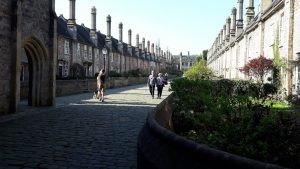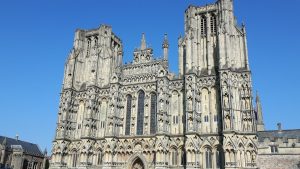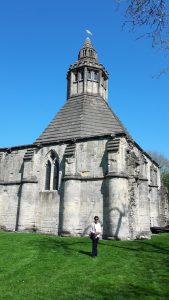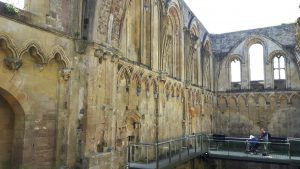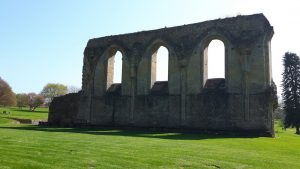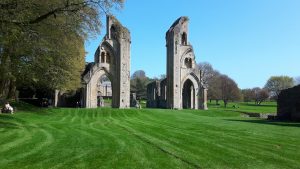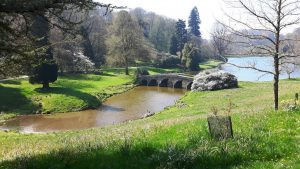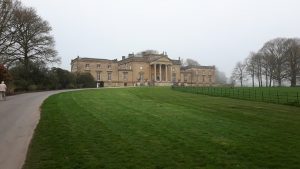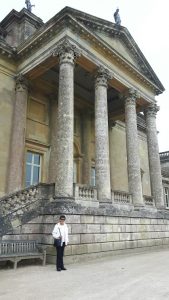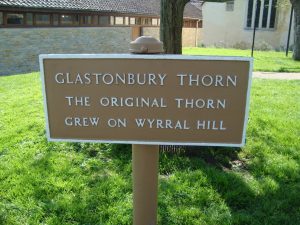Day 12
Over breakfast, Roger urged us to detour a little from our plans and include Stourhead, in Wiltshire. “Why not,” said Hilary. And so, we did!
What a treat as we visited this magnificent home of immense proportions, standing on a hill and surrounded by 1,072 hectares of woodlands and gardens, and lakes and temples.
It was created in the 18th century by a banking family, the Hoares. The bank was originally created in the 17th century by Sir Richard Hoare. Its funds aided the development of Stourheads garden, house and estate under seven owners from the Hoare family, until it passed to us in 1947. {The National Trust} These seven owners had varying levels of input, both in the family bank and at Stourhead…
Perhaps the most beautiful and magical of all of the great landscape gardens, Stourhead presents an English 18th-century view of Arcadian paradise. With hills, water and classical architecture overlaid by a fabulous collection of trees and shrubs, Stourhead was described as ‘a living work of art’ when first opened in the 1740s. Meandering paths offer vistas through trees to classical temples and surprises at every turn. Stourhead is breathtaking in any season but on sunny spring and autumn days, the flowering spring shrubs and the flaming autumnal colours of the trees reflected in the magnificent lake are breathtaking. Source: National Trust
In the house, one of the tour guides gave us a map of the main floor with its many rooms. The library was particularly impressive with a half-moon stained-glass window at its far end. At last count, in December 2014, it housed over 6,474 books. We can only surmise more books are added periodically.
You will recall there were seven generations of Hoares who owned Stourhead.
Sir Richard Colt Hoare, 2nd Baronet FRS (December 9th 1758-19 May 1838) was an English antiquarian, archaeologist, artist, and traveller of the 18th and 19th centuries, the first major figure in the detailed study of the history of his home county, Wiltshire. {Source Stourheads website)
Sadly, his wife died in childbirth, and his grandfather soon after. Sir Richard was so distraught, he left England and travelled the continent for six years. Eventually, he returned and stayed true to his grandfather’s vision for the gardens. The classical Italian design was completed, along with the building of the library.
The library, as well as housing hundreds of books, holds many notes, and diaries of the family’s travels, as well as letters and newspaper cuttings. Of interest, Sir Richard’s son, Sir Henry Hoare, was married to a lady who was an ardent fan of Thomas Hardy, she had a lifelong friendship with him and both of his wives. All of Hardy’s works and the many letters they exchanged are on the library shelves too.
I would be amiss If I did not mention the Italian Room. The family was enamored with Italian art, and evidence of it can be seen throughout the house, beautiful paintings, sculptures, and statues.
We did spend some time in the Italian Room viewing one particular item, The Pope’s Cabinet.
Acknowledgement: The following description has been edited from an article in the London Daily Telegraph published in 2007. I copied it from Stourhead’s website!
‘This priceless Renaissance cabinet was afforded a ₤50,000 refurbishment in 2007. The four-storey structure was designed as a miniature church for Pope Sixtus V between 1585 and 1590.
Standing 13ft high and clad in bronze, silver and marble and semi-precious stones, it has been described as one of the most remarkable pieces of furniture in the world. The doors and windows of the Pope’s Cabinet are cupboards and drawers.
It is covered using a technique called pietre dure, which uses different coloured pieces of highly polished marble, porphyry, jasper and other materials to create the designs.
Altogether it contains 150 drawers, some so hidden that the craftsmen could hardly find them – and one which still cannot be opened.
The cabinet was bought by Henry Hoare (1705-85), during a grand tour he made that took in Rome.’
As we strolled the grounds, at least some of them, we had a splendid vista of the pantheon standing on a hill across the lake. The hill sloped gently down to the edge of the water. It was bereft of its daffodils. They were all but finished, their beautiful yellow heads closed down and brown in colour. But other flowers were springing forth.
Because of the vastness of Stourhead, a book would have to be written about it, Although I think a movie might be a good option. To see all Stourhead has to offer many hours would have to be spent there. There are a few cottages on the grounds for rent, the ideal option for visitors travelling a distance. Meanwhile, do go to this website and enjoy the excellent pictures of fascinating Stourhead. http://www.stourhead.colindaylinks.com/intro.html
As for me, I thought another trip to England is warranted as we drove to Glastonbury, another site that begs more than one visit.
Glastonbury is steeped in history. The ruins of a once-grand Abbey are breathtaking. Needless to say, it fell under the axe at the time of the dissolutions of the monasteries. The abbot was executed along with two other monks, and the rest of the monks were driven out. Local folk took much of the stone and built cottages and houses for themselves.
It is worth noting that at this time in history, the abbeys, cathedrals, and monasteries of Europe came under the authority of the pope. The monks were given vast amounts of money by the kings to fund the creation of their buildings. In turn, statues of kings are seen in the ruins, and indeed in cathedrals to this very day.
But despite Glastonbury’s sad demise, it flourishes today as an attractive tourist location. The ruins stand majestically amid wide expanses of beautifully kept lawns. Legends swirl around Glastonbury, even that Jesus went there as a boy with Joseph of Arimathea, and that Joseph stuck his staff into the ground and it blossomed into the Glastonbury Thorn Tree. Now, this does make for some interesting speculation. Scientists have proved that the thorn tree is from the middle east. While Hilary snapped pictures of the tree, I read in the guide book that it blossoms three times a year, the third time at Christmas. The Queen has a sprig from the tree on her desk over the Christmas season.
With decided determination, we went looking for the spot where the legendary King Arthur and Queen Guinevere are supposedly buried. We found it! A sign informed us that this was the spot where the monks had dug searching for the king’s remains.
The Abbey Kitchen was a separate building and had survived the destruction. We went inside and took more pictures, one of David stirring a pot hanging over a fire, and another of Hilary and I standing in front of a life-sized monk and a servant girl. We then made our way to the gift shop. Hilary and I bought small items, and David waited patiently.
It would not be right to move on without mentioning William Blake’s poem, Jerusalem. Blake was born in 1759 and had firm beliefs that Jesus really did walk on England’s mountains green. His poem, later, classified as a hymn, was put to music by Sir Hubert Parry in 1916. Hilary, David, and I, along with thousands of school children, recalled learning the hymn in our respective schools. We sang it with great gusto on special occasions. It became something of an enigma, when it went from church and school assembly to football games. I’m not sure how that transpired, but hearing thousands of voices singing Jerusalem, at football matches stirs the heart of any English person.
And did those feet in ancient time,
Walk upon England’s] mountains green:
And was the holy Lamb of God,
On England’s pleasant pastures seen!
And did the Countenance Divine,
Shine forth upon our clouded hills?
And was Jerusalem builded here,
Among these dark Satanic Mills?
Bring me my Bow of burning gold;
Bring me my Arrows of desire:
Bring me my Spear: O clouds unfold!
Bring me my Chariot of fire!
I will not cease from Mental Fight,
Nor shall my Sword sleep in my hand:
Till we have built Jerusalem,
In England’s green & pleasant land.
From Glastonbury, we drove to Wells, the smallest city in England. Its Cathedral has been described as the jewel in the crown of English cathedrals. We parked the car in a parking lot and could see the Cathedral spires over the tops of buildings. Since there were several exits out of the square, we asked a congenial young man how to get to our destination, and cheerfully he gave us instructions.
Walking along High Street, our tummies were rumbling, possibly because we noted several little cafés along the way. We stopped at one situated on the corner where the road swept around to the left. There we sat at one of the tables on the sidewalk with a stellar view of the city centre and enjoyed refreshments. A group of young people posed in front of the Market Cross, an imposing-looking stone structure in the market square with steps leading up to the middle. We were curious to know more about market crosses, which we discovered are in their thousands all across England, Scotland, and Wales. British immigrants in their new countries, for example, Canada and Australia, built market crosses too. The designs vary greatly, some look like temples, with a myriad of intricate carvings.
But simply put, they indicate the area where markets can be held on certain days, and in centuries gone by permission had to be granted by the monarch, or the bishop of the diocese. Wells Market Square comes alive twice a week with every product imaginable for sale. Not only that, but choirs, dance groups, & buskers add to the festivities for the day.
Refreshed after our tea, we made our way to The Penniless Porch, an entrance gateway into a walled area. The porch was built around 1450. For poor folk, it was a place where they could beg.
Through the gateway, we went and out on to the green. Schoolgirls sat in a circle laughing and chatting, a woman was sleeping on the grass, and others lounging here and there in the warm sunshine. The magnificent Cathedral stood before us, and bird song praised its presence.
‘The present Cathedral was begun about 1175 on a new site to the north of the old minster church. Bishop Reginald de Bohun brought the idea of a revolutionary architectural style from France, and Wells was the first English Cathedral to be built entirely in this new Gothic style. The first building phase took about eighty years, building from east to west, culminating in the magnificent West Front. About 300 of its original medieval statues remain: a glorious theatrical stone backdrop for feast day processions.
…Wells Cathedral has unique features that separate it from other English cathedrals including the beautiful ‘scissor arches’ supporting the central tower; a structure which was added in 1338 after the weight of a new spire on the top of the tower threatened to collapse the whole thing. The Cathedral houses one of the largest collections of historic stained glass in the country. Experts agree that the Jesse Window at Wells Cathedral is one of the most splendid examples of 14th century stained glass in Europe, narrowly escaping destruction during the English Civil War. The Cathedral also boasts the famous Wells Clock (which is considered to be the second oldest clock mechanism in Great Britain…’
Adjoining the Cathedral is Vicars’ Close, believed to be the only complete medieval street left in England. This significant landmark was designed to provide communal accommodation for the Vicars Choral, who sang daily worship within the Cathedral. This centuries-old tradition continues today and is a unique and much-valued part of life at Wells Cathedral.’ Source: One of Wells many websites.
We walked across the green and had a peek at the Vicar’s Close, before heading into the Cathedral where we attended evensong. A girls’ choir sang Choral Evensong. Their beautiful voices soaring to the rafters.
At the end of the service, it was time to head back to the hotel. We decided if we should spot a restaurant or pub along the way we would stop for dinner, The Masons Arms lured us in, and soon enough we were enjoying the delicious fare. I opted for the shepherds’ pie and vegetables. I was not disappointed.
A long day over, we retired to our rooms.

